August 2014
- Jack Harrison
- Posts: 4627
- Joined: Wed Jan 18, 2006 8:55 pm
- Location: Nairn, Highland
- Contact:
Re: August 2014
Carlisle 2nd - 4th August
There for non-butterfly reasons. But noted that GV Whites quite the most numerous species.
I don't know what race they belong to.
Indoors in guest house, two Tortoiseshells hibernating. Seen outside one Peacock. On a birding note, Tree Sparrows.
Jack
There for non-butterfly reasons. But noted that GV Whites quite the most numerous species.
I don't know what race they belong to.
Indoors in guest house, two Tortoiseshells hibernating. Seen outside one Peacock. On a birding note, Tree Sparrows.
Jack
Re: August 2014
Second broods are certainly providing the interest at the moment, now that Brown Hairstreak have emerged and Clouded Yellow made their appearance. More migrants to come? .
2n brood Brown Argus today.... and Common Blue female....
2n brood Brown Argus today.... and Common Blue female....
"Conservation starts in small places, close to home..."
Re: August 2014
And especially for PhilB and Rogerdodge, who I know just love butterflies on garden plants....
...here's one I took today....
...here's one I took today....
"Conservation starts in small places, close to home..."
-
adrian riley
- Posts: 135
- Joined: Sun Dec 20, 2009 12:28 pm
Re: August 2014
Hi, Peternomad wrote:Hi all- I went to Bernwood Forest in Oxon today to search for Brown Hairstreaks, having seen Phil's lovely images I should have really have gone to Otmoor. I have a long association with both places. When I was a boy, my father used to take me to Otmoor to listen to the Grasshopper Warblers, with my hearing I probably could not hear them today. All I remember then of Otmoor was long grass, brambles and sedges. In the 1970's I used to visit the lane leading to Hell's Coppice of Bernwood in September and remember seeing egg-laying female Brown Hairstreaks. Hence E.B Ford noting that most people look for them too early. In Bernwood Forest I visited the M40 Compensation area , but only saw my sought after butterfly high up in the Ashes and couple flying fast over the tops of the Sloe bushes. I did see a herd of Fallow deer, a Roe and a Muntjac and their droppings all over the place. All round the site the Sloe bushes were nearly all stripped of their foliage between three to five feet from the ground. Many of the young Sloe seemed dead from the attentions of the many deer. There is a deer fence around the site, but the animals have pushed under where there are banks and when I arrived the gate was wide open. I wonder if all this damage impacts on the Brown Hairstreak population. It certainly will in the future. Probably my biggest surprise was finding a Chalkhill Blue male in the M40 Compensation meadows. Later I visited Bernwood meadows nature reserve, but again no luck except for two females? speeding along the tops of the Sloe hedges. Here I found the smallest Common Blue I have ever seen, about the size of a male Small Blue. I wondered has anybody ever photographed Brown Hairstreaks at Bernwood?
Regards Peter
Always found the females easy enough at Bernwood Meadow.
Happy hunting,
Adrian Riley
-
adrian riley
- Posts: 135
- Joined: Sun Dec 20, 2009 12:28 pm
Re: August 2014
There's still Camberwell Beauty, Queen of Spain, Long-tailed Blue and MonarchWillrow wrote:Visited Rodborough Common, Gloucestershire yesterday to spend the day with the 'blues'...Chalkhill & Adonis Blue that isThe former were in countless hundreds on Swellshill Bank and in healthy numbers elsewhere throughout the common, the latter however were in very short supply - I saw perhaps just half a dozen during the entire day
Chalkhill Blue put my seasons species list onto 50 and I think that is it for the season now, I'm happy to see so many speciesbut sad that all the British species have now appeared
the season has just whizzed along
having said that there is still much to be enjoyed with the remaining species still 'out and about' its just the thought that there are no other species to look forward too

There was lots of mating activity on Swellshill and I had several opportunities to record some photographs, I must however warn the more prudish viewer that the image below of 'in-cop' chalkies is rather 'graphic'so don't look

Among the other blues were good numbers of Brown Argus and Common Blue the former species usually appeared nice and fresh looking, just as we like em' for a snapshots eh
Yesterday I saw more Small Copper than the rest of the year in totalwith at least a dozen seen, the species has done poorly this year, lets hope this lovely little butterfly does much better next year.
A bonus during my visit came in the form of a hyper fast fly-by Clouded Yellow which if memory serves is only the second I've seen this year, as I attempted pursuit it fooled me by doubling back (sneaky b*gg*r) and almost hit me in the head before soaring over the near trees and away
...so there was no record photograph obtained again this year

In total 20 species seen and I'm usually quite pleased to see a third of the British species list in one day...everyone should be...don't you think?
Bill
"When in doubt...venture out"
'When in doubt, have a pint'
Re: August 2014
Yes - Majority of Small Tortoiseshell seem to have withdrawn into hibernation, though I have seen a few caterpillar webs in the last week.Jack Harrison wrote:Carlisle 2nd - 4th August
Indoors in guest house, two Tortoiseshells hibernating.
Jack
Our Recorder is going to look at what the data says about hibernation "date" for the ST down here, where Summer is passing to Autumn quite early, it seems...
"Conservation starts in small places, close to home..."
-
adrian riley
- Posts: 135
- Joined: Sun Dec 20, 2009 12:28 pm
Re: August 2014
The entirely black legs are diagnostic of Ruddy Darter. The anal appendages (though viewed from an awkward angle) suggest female.Ian Pratt wrote:A magical moment today when I was looking for butterflies at Mill Copse Yarmouth IOW. I was looking at some bramble and suddenly something was flitting around me like a will o' the wisp and landed on my hand enabling me to photograph it. It reminded me of Tinkerbell in Peter Pan. I believe it is a female ruddy darter but possibly a female common darter.
Ian
Adrian Riley
- Essex Bertie
- Posts: 246
- Joined: Sat Jul 24, 2010 6:16 pm
- Location: Brentwood, Essex
Re: August 2014
[/quote] Yes - Majority of Small Tortoiseshell seem to have withdrawn into hibernation, though I have seen a few caterpillar webs in the last week. [/quote]
Nick,
We should be getting another Small Tort brood down South - it's these that will be the main hibernators. Or are you saying that some of the early summer brood hibernate too?
I find it all confusing but fascinating that the early summer brood down South will instinctively mate, but those emerging later further north are only interested in getting their head down.
Cheers
Rob
Nick,
We should be getting another Small Tort brood down South - it's these that will be the main hibernators. Or are you saying that some of the early summer brood hibernate too?
I find it all confusing but fascinating that the early summer brood down South will instinctively mate, but those emerging later further north are only interested in getting their head down.
Cheers
Rob
Re: August 2014
It would seem that more Swallowtails are emerging in Sussex (Twitter). Anyone got any more details?
- Mark Tutton
- Posts: 460
- Joined: Sun Apr 25, 2010 7:21 am
- Location: Hampshire
Re: August 2014
Hi Pauline - four or five have apparently emerged in a Rustington garden
Kind Regards
Mark
Kind Regards
Mark
The wonder of the world, the beauty and the power, the shapes of things, their colours lights and shades, these I saw. Look ye also while life lasts.
Re: August 2014
Seen today at Brading Down IOW this evening.
Small tortoiseshell from yesterday too.
Ian
Small tortoiseshell from yesterday too.
Ian
-
jasonbirder
- Posts: 185
- Joined: Sun Mar 09, 2014 3:42 pm
Re: August 2014
A really "late summer" feel to yesterdays Butterfly outing (August 7th)
Visited a trio of South-Eastern sites to catch up with the late summer specialties and was rewarded with good numbers of Silver-spotted Skipper at Ashton Rowant (and lots of second brood Small Heath)
One photogenic (and a couple of rather more flighty) Brown Hairstreak at Shipton Bellinger alongside good numbers of second brood Holly Blue
And lots of faded looking Chalkhill Blue and rather fewer fresher second brood Adonis Blue at Denbies Hillside...
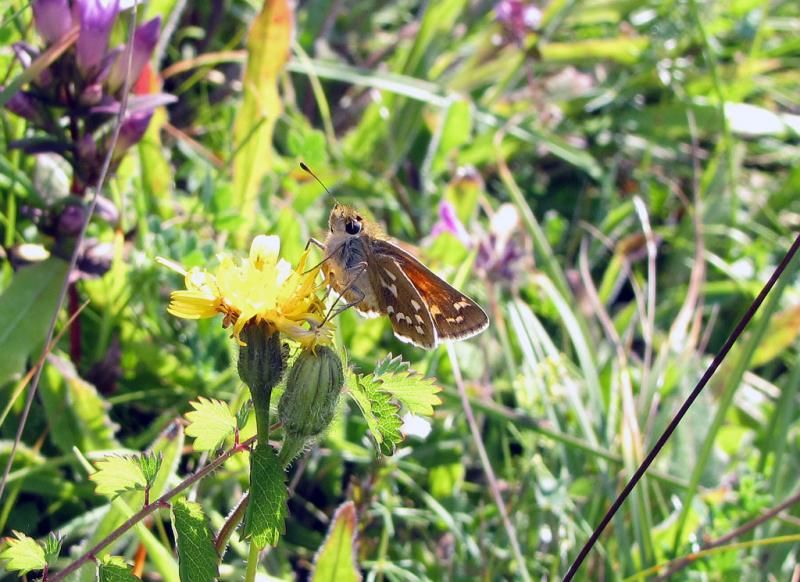
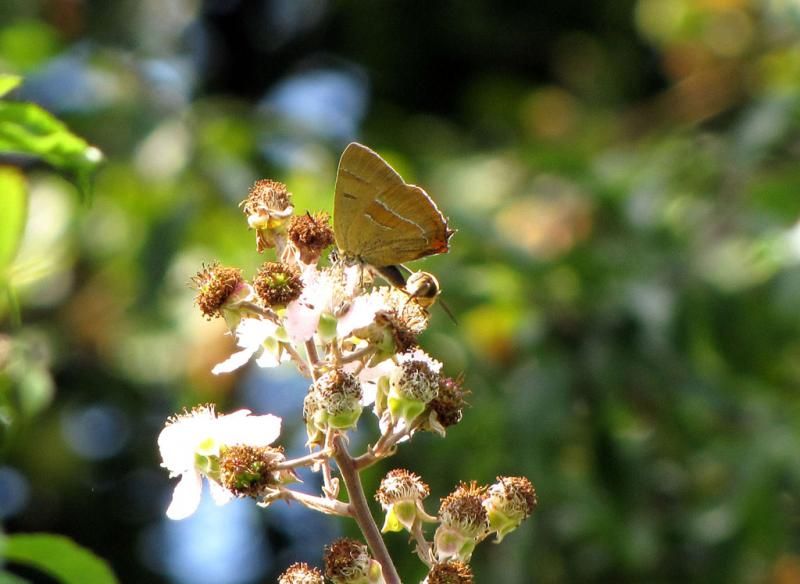
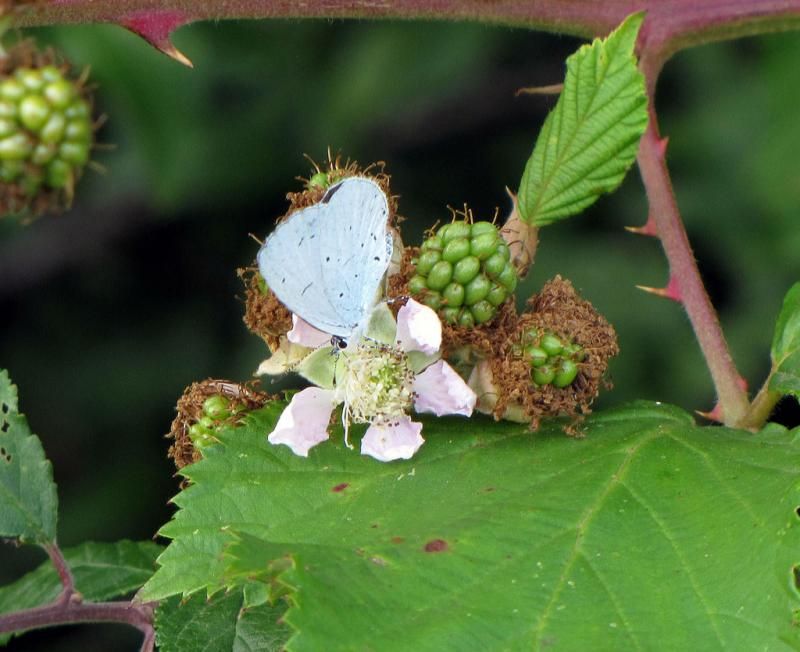
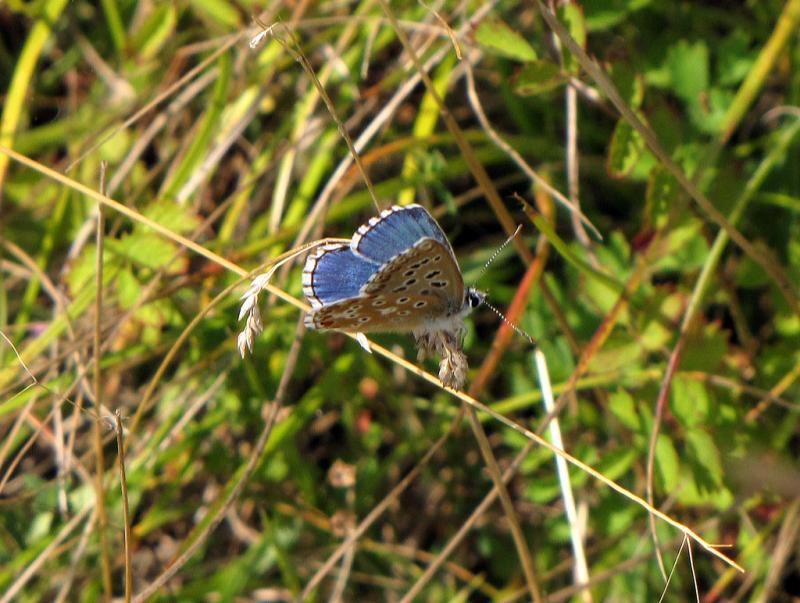
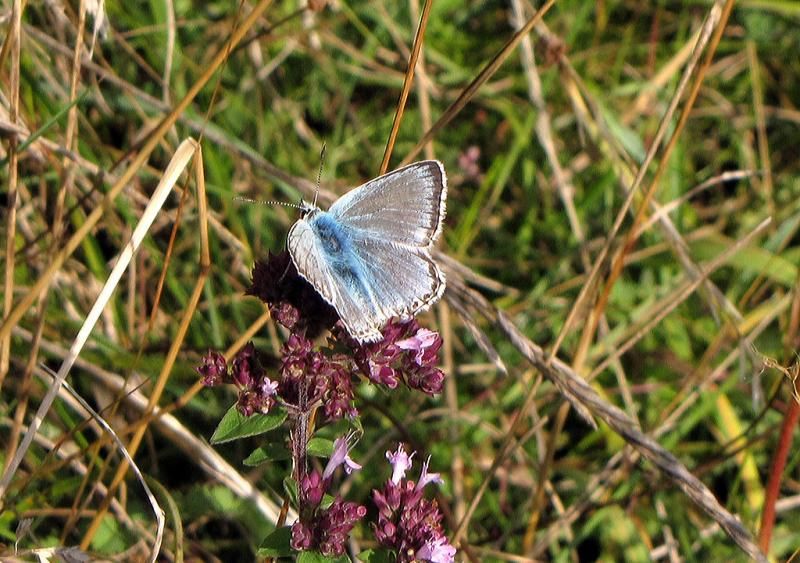
Visited a trio of South-Eastern sites to catch up with the late summer specialties and was rewarded with good numbers of Silver-spotted Skipper at Ashton Rowant (and lots of second brood Small Heath)
One photogenic (and a couple of rather more flighty) Brown Hairstreak at Shipton Bellinger alongside good numbers of second brood Holly Blue
And lots of faded looking Chalkhill Blue and rather fewer fresher second brood Adonis Blue at Denbies Hillside...





Re: August 2014
Hi all. I visited Otmoor in Oxon today to look for Brown Hairstreaks. There were many people along the Roman Road from far and wide, all hoping for some good photography, but as far as I know most came away a wee bit disappointed. The Ash Brownie bonanza did not happen, except in one Ash tree where a few worn males and two pristine females were spotted. During the whole day none seemed to be visiting flowers, in spite of the mainly warm sunshine. One female spent the entire morning resting quite high up on an Ash twig, without moving. Some photographers moved off to see the Clouded Yellows along the footpaths to the bird hides. Otmoor with its vast views is a very lovely area and I would be very interested if there is a historic description of it before the moor was drained during the mid 19th century. I have read although it was drained, it was even under water in the winter months up to the 1920's. So again are there any old photographs of Otmoor. So if you can help, please P.M me. Many thanks and Best Wishes
Peter.
Peter.
- Jack Harrison
- Posts: 4627
- Joined: Wed Jan 18, 2006 8:55 pm
- Location: Nairn, Highland
- Contact:
Re: August 2014
Two very fresh Red Admirals in my Isle of Mull garden today, clearly locally born. Indeed, in both the last two springs (May) I have seen Red Admirals so the suspicion is that they over-winter here is small numbers. There are few frosts in coastal Mull courtesy the Gulf Stream. My lowest recorded temperature last winter was minus 0.6C. There was just one other frost.
Jack
Jack
Re: August 2014
Significant numbers of Scotch Argus seen at Smardale Gill, near Brough, Cumbria, on 4th August:
This is the alternative English site for this species, and they can be easily observed here in what is a particularly beautiful location, being situated around a disused railway line with a restored viaduct that can be walked across:
This is the alternative English site for this species, and they can be easily observed here in what is a particularly beautiful location, being situated around a disused railway line with a restored viaduct that can be walked across:
-
Testudo Man
- Posts: 488
- Joined: Thu Sep 26, 2013 8:21 pm
- Location: Kent
Re: August 2014
A wash out today! and a "family day" yesterday, meant no butterfly/wildlife sessions for this weekend!
So, last weekend saw me visit both Queensdown Warren and Darland Banks (2 Kent sites).
The SSS's were active at Queensdown Warren, on 2 occasions, i saw a male attempt mating, but didnt witness any cop.
Then onto Darland Banks, to sight a few 2nd brood Adonis Blues. I think i only saw one or two males though.
Not a butterfly, but found a large orange coloured Robberfly! Had to goggle this beast, and it would appear to be A Hornet Robberfly. This would be the 1st time i have seen one of these "assassins", and WOW, what a killing machine!
Several photos, cheers Paul.
Location- Kent.
If you should come across one of these Hornet Robberflies, they are quite a bit larger than a normal, more common Robberfly.
This last image shows the Robberfly with its prey, which would be a large adult grasshopper...It flew past me then landed, clutching its victim.
So, last weekend saw me visit both Queensdown Warren and Darland Banks (2 Kent sites).
The SSS's were active at Queensdown Warren, on 2 occasions, i saw a male attempt mating, but didnt witness any cop.
Then onto Darland Banks, to sight a few 2nd brood Adonis Blues. I think i only saw one or two males though.
Not a butterfly, but found a large orange coloured Robberfly! Had to goggle this beast, and it would appear to be A Hornet Robberfly. This would be the 1st time i have seen one of these "assassins", and WOW, what a killing machine!
Several photos, cheers Paul.
Location- Kent.
If you should come across one of these Hornet Robberflies, they are quite a bit larger than a normal, more common Robberfly.
This last image shows the Robberfly with its prey, which would be a large adult grasshopper...It flew past me then landed, clutching its victim.
Re: August 2014
Saw a Clouded Yellow near Wrexham today - very unusual for these parts. The last time I saw one round here was in 2001 - although I have seen them on the north west Wales coast since. Either it's a Clouded Yellow year or the storms have blown it north and east - probably the latter.
Re: August 2014
Interesting comment. You may well be right.A_T wrote:Saw a Clouded Yellow near Wrexham today - very unusual for these parts. The last time I saw one round here was in 2001 - although I have seen them on the north west Wales coast since. Either it's a Clouded Yellow year or the storms have blown it north and east - probably the latter.
Given that these winds have come from the other side of the Atlantic, might this also make Monarch landfalls more likely this year?
Re: August 2014
It's a probably bit early for that. Monarchs that end up in the UK are generally believed to be caught up by powerful weather systems whilst they are embarking on their southward migration down the east coast of the US and Canada. This is why the majority of these sightings are in late September/October. Any that appear earlier in the year are suspected to originate in Iberia or the Canaries where the resident populations appear not normally to migrate (I have no idea why this might be). The current weather system is of the right sort (though it has taken several days to reach us and didn't approach the US coast that closely), but I don't think the Monarchs will be migrating south just yet, so wouldn't have been within its reach. This is what I've picked up from various sources - it seems to make sense.
Dave
Dave
Re: August 2014
Went to Bookham Commons yesterday in the hope of seeing my first Brown Hairstreak of the year. Thankfully the good weather day was on Saturday rather than Sunday as it would've been difficult to do anything due to the road closures for the cycle race (contrary to the media hype not everyone welcomes this event).
At the downside end of the commons I was quickly into my searching and enjoying the familiar flora and fauna which was in stark contrast to that of searching the arid rocky terrain that is South Tenerife. A report on my holiday to the canaries will follow later in the year (still have masses of pictures to sort and not enough hard drive space to accommodate them).
Despite ideal weather conditions and an extensive search I didn't get a sniff of a Brostreak (have let the side down sorry David
 ). Plenty of the usual suspects - and the unusual with a Clouded Yellow in the overgrown meadow area across from Nightingale corner
). Plenty of the usual suspects - and the unusual with a Clouded Yellow in the overgrown meadow area across from Nightingale corner  . As is often with Cloudies it moved fast and didn't stop
. As is often with Cloudies it moved fast and didn't stop  .
.
First butterfly encountered was a lovely Red Admiral, something I've not seen much of this year .
Other butterflies seen were lots of False Hairstreaks (Gatekeepers); Meadow Browns; Speckled Wood and the three Whites. A solitary Comma and male Silver-washed Fritillary put in an appearance too.
In one 4 hour visit to Bookham I have managed to see more species of butterfly than I had in my two weeks in Tenerife.
.
Other butterflies seen were lots of False Hairstreaks (Gatekeepers); Meadow Browns; Speckled Wood and the three Whites. A solitary Comma and male Silver-washed Fritillary put in an appearance too.
In one 4 hour visit to Bookham I have managed to see more species of butterfly than I had in my two weeks in Tenerife.
Species seen:- LWt; SWt; GvWt; CY; MB; Gk; SWF; RA; Cm; SWd; CB; SSk and Peacock.
Moving on to Denbies in the late afternoon ... and the cloud cover had become a bit more extensive . I made my way over to the paddock on the LH side of Steers Field specifically to see Silver-spotted Skippers. Up until then I had not seen any Chalkhill Blues (being out of the country during their emergence) or second generation Adonis, but counted on them being in this area. The entrance to the paddock was a bit of an eye opener with the vegetation flattened and cow dung everywhere
. I made my way over to the paddock on the LH side of Steers Field specifically to see Silver-spotted Skippers. Up until then I had not seen any Chalkhill Blues (being out of the country during their emergence) or second generation Adonis, but counted on them being in this area. The entrance to the paddock was a bit of an eye opener with the vegetation flattened and cow dung everywhere  . It was being grazed by at least 12 Belted Galloway cattle. I understand this is to keep the scrub in check but a dozen seems excessive to me
. It was being grazed by at least 12 Belted Galloway cattle. I understand this is to keep the scrub in check but a dozen seems excessive to me  .
.
Despite the trampled/trashed appearance there were butterflies about - not in any great number but there nevertheless . A fresh male Chalky put in an appearance and sheltered low in the grasses out of the wind whipping up the hillside. In the moments when the wind died down sun peeped out from the clouds I was able to trace a couple of Silver-spots, but these were difficult to photo. Unfortunately I didn't see any Adonis.
On the way home I followed up a lead on Sheepleas which is a mixture of woodland, scrub and open grassland and is managed by the Surrey Wildlife Trust (Denbies by the National Trust). I was pleasantly surpised just how pristine the meadows were in comparison to Denbies. As it was starting to get late I did a quick tour of the wildflower meadows. Will definitely explore this area again
. A fresh male Chalky put in an appearance and sheltered low in the grasses out of the wind whipping up the hillside. In the moments when the wind died down sun peeped out from the clouds I was able to trace a couple of Silver-spots, but these were difficult to photo. Unfortunately I didn't see any Adonis.
On the way home I followed up a lead on Sheepleas which is a mixture of woodland, scrub and open grassland and is managed by the Surrey Wildlife Trust (Denbies by the National Trust). I was pleasantly surpised just how pristine the meadows were in comparison to Denbies. As it was starting to get late I did a quick tour of the wildflower meadows. Will definitely explore this area again  .
Phil
.
Phil
At the downside end of the commons I was quickly into my searching and enjoying the familiar flora and fauna which was in stark contrast to that of searching the arid rocky terrain that is South Tenerife. A report on my holiday to the canaries will follow later in the year (still have masses of pictures to sort and not enough hard drive space to accommodate them).
Despite ideal weather conditions and an extensive search I didn't get a sniff of a Brostreak (have let the side down sorry David
First butterfly encountered was a lovely Red Admiral, something I've not seen much of this year
Species seen:- LWt; SWt; GvWt; CY; MB; Gk; SWF; RA; Cm; SWd; CB; SSk and Peacock.
Moving on to Denbies in the late afternoon ... and the cloud cover had become a bit more extensive
Despite the trampled/trashed appearance there were butterflies about - not in any great number but there nevertheless
